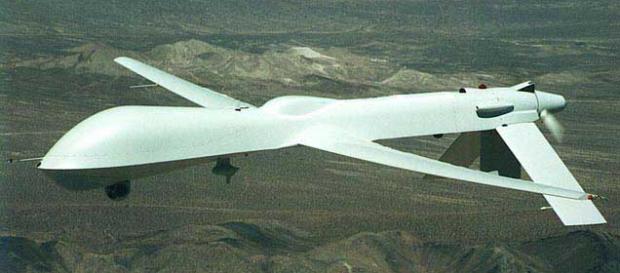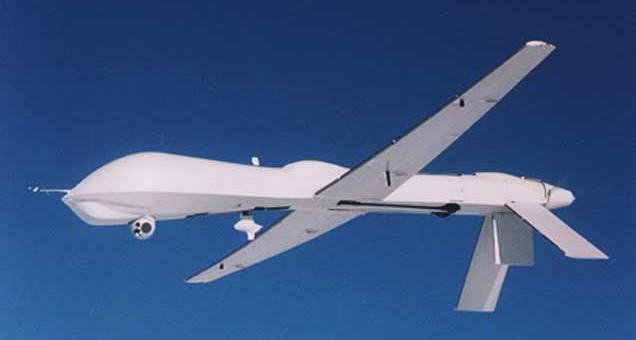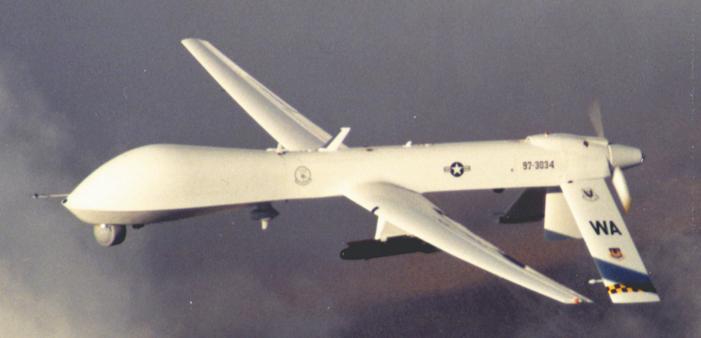General Atomics RQ/MQ-1 Predator
The Predator is the U.S. Air Force's first operational tactical multimission UAV. In January 1994, General Atomics Aeronautical Systems Inc. (GA-ASI) was awarded an ACTD (Advanced Concept Technology Demonstration) contract by DARPA for the Predator, which was to fulfill a requirement known as "Tier II" MAE (Medium Altitude Endurance) UAV. The Predator, which first flew in July 1994, was based on GA-ASI's earlier Gnat-750 UAV, which was itself derived from Amber vehicle, built in the late 1980s. While still under development, the Predator was first used operationally in July 1995 in Albania to monitor Serbian installations. Two vehicles were lost during these missions. The ACTD phase of the program ended in June 1996, and the first LRIP (Low Rate Initial Production) contract for Predator was subsequently awarded in August 1997.
At the same time, the DOD introduced a new Q-for-UAV category in its designation system for manned aircraft, and the Predator was accordingly designated RQ-1. However, the aircraft designation system was used for the Predator in a non-standard way. The designation RQ-1A refers to a whole UAV system (including ground equipment) in the ACTD configuration, while the air vehicles are designated RQ-1K. Other components of the Predator system also have designations in the RQ-1 series, which will be mentioned below.
 |
| Photo: General Atomics |
| RQ-1K |
The RQ-1K is powered by a Rotax 912 UL piston engine driving a two-blade pusher propeller, and features an inverted V-tail. With its fully retractable tricycle landing gear, the Predator takes off and lands like a conventional aeroplane. It has a fixed nose-mounted colour TV camera for remote piloting, and for automatic navigation, it is equipped with a GPS-aided inertial navigation system. Primary mission equipment of the RQ-1K is a Northrop Grumman AN/ZPQ-1 TESAR (Tactical Endurance Synthetic Aperture Radar) surveillance radar and a Wescam Versatron 14TS IR/EO (Infrared/Electro-Optical) sensor turret.
Ground equipment of an RQ-1A system includes the RQ-1P GCS (Ground Control Station), which uses C- and Ku-Band datalinks for LOS (Line-Of-Sight) and non-LOS communication with the UAV, respectively. Range of the non-LOS link, and therefore the effective operational radius of the aircraft, is about 740 km (400 nm). Non-LOS communications in the first three Predator systems was handled via an AN/TSQ-190(V) Trojan SPIRIT II SATCOM link, which was designated as RQ-1U within the Predator system nomenclature. The Predator UAV can be programmed to automatically return to base if the datalink is lost.
Development of the upgraded Block 1 version of the Predator system began in 1998, and was completed in the 2000/01 time frame. Designated RQ-1B, a Block 1 system comprises improvements to the UAV and the communications equipment. The RQ-1L air vehicle has a higher-performance turbo-supercharged Rotax 914 UL engine and de-icing equipment. It can reach an altitude of about 7920 m (26000 ft), where it can cruise for at least 20 (and possibly up to 24) hours at 110-130 km/h (60-70 knots). On later RQ-1Ls, the Wescam 14TS is replaced by a Raytheon AN/AAS-52(V) MTS (Multi-Spectral Targeting System) EO/IR sensor turret which also houses a laser designator. Ground equipment improvements include a secure ATC (Air Traffic Control) voice relay, a second datalink in the GCS to support simultaneous control of two UAVs, an Air Force Mission Support System (AFMSS) workstation in the GCS, and general maintainablity and reliability upgrades. The Block 1 GCS is designated as RQ-1Q, while the current Predator satellite link (which has replaced the Trojan SPIRIT II) is known as RQ-1W PPSL (Predator Primary Satellite Link) (there is apparently no -1V designation).
 |
| Photo: General Atomics |
| RQ-1L |
Further improvements of the Predator system, designated as Block 10 and 20, are also known to have been procured. Changes in the Block 10 air vehicle include a wingtip extension for improved performance in high and hot environments. It is planned to upgrade all surviving Predator airframes to this standard. A new nomenclature has been introduced for some of the ground equipment used for UAV control. The latter is now designated in a D-series (D = Drone Control). The Block 20 GCS is the MD-1A, while the designation MD-1B refers to the so-called Predator LRCS (Launch and Recovery Control Station), which can be used not only with the MQ/RQ-1, but also with the new MQ-9 Predator B. The MD-1C is the CDCS (Containerized Dual Control Station), which can pass control to a fully functional station after launch. The MD-1D is a multi-aircraft control station, in which one pilot and four sensor operators can control up to four UAVs simultaneously.
Probably the most important upgrade of the Predator system is the arming of the UAV with air-launched guided missiles. The development program was begun in 2000, and in February 2001 an AGM-114C Hellfire laser-guided anti-armour missile was fired for the first time from an RQ-1L equipped with a wing-mounted missile launch pylon and the laser designator of the AN/AAS-52(V). This achievement has been hyped as "first guided missile launch by an UAV", which somewhat overlooks the fact that experimental BGM-34A Firebee UAVs had launched AGM-65 Maverick missiles already in 1971/72. In February 2002, those RQ-1Ls, which are equipped to launch Hellfire, were redesignated as MQ-1L. The designation of the corresponding Predator system also changed to MQ-1B. Other missiles and guided weapons, including the FIM-92 Stinger air-to-air missile, are evaluated and/or operationally used on the MQ-1L as well. Since 2001, the RQ/MQ-1 has been extensively used in U.S. operations in Afghanistan and Iraq, including armed ground attack missions by MQ-1Ls.
 |
| Photo: General Atomics |
| MQ-1L |
The USAF has currently three operational Predator squadrons in service. To cover attrition and expansion of the Predator inventory, GA-ASI currently has contracts for the production of more than 250 RQ/MQ-1 aircraft, about 120 of which have already been delivered. The U.S. Navy is also evaluating the Predator as a multitole UAV. At the time of this writing, the USAF is evaluating the a larger and more capable derivative of the Predator, the MQ-9 Predator B, which will eventually supplement the MQ-1.
Warrior ERMP UAS
In 2002 the U.S. Army began the Extended Range Multi-Purpose (ERMP) UAS program for a long-endurance armed unmanned aerial system, and by 2004 two competitors had submitted proposals. In August 2005, the General Atomics Warrior was announced as the winner of the competition against the the Northrop Grumman Hunter II (an enlarged derivative of the MQ-5B Hunter). In late 2006, the designation YMQ-1C was officially allocated to Warrior prototypes.
The Warrior is a variant of the MQ-1 Predator, the main difference being a larger wing and a new engine. The UAV is powered by a Thielert "Centurion" Heavy Fuel Engine (HFE) for higher performance, better fuel-efficiency and longer lifetime. The Warrior's main sensors are an SAR/GMTI (Synthetic Aperture Radar/Ground Moving Target Indicator) in the large fairing, and an EO/IR (Electro-Optical/Infrared) turret under the nose. It is equipped with underwing hardpoints, and currently planned weapon options include the AGM-114 Hellfire missile and the GBU-44/B Viper Strike guided bomb.
 |
| Photo: General Atomics |
| YMQ-1C |
The Army's Warrior UAVs will normally fly autonomous missions, and use the same GCS (Ground Control Station) as the RQ-7 Shadow 200 system. It will eventually replace the MQ-5 Hunter, and IOC (Initial Operational Capability) of the MQ-1C is planned for 2009. The Army has a requirement for about 120 Warrior air vehicles.
Designation note: The Army has referred to the Warrior as "MQ-12" in at least one published statement. According to unofficial information, the designation YMQ-12A has indeed been requested by the Army, but this request was turned down by the DOD, which allocated YMQ-1C instead. The Army is apparently not entirely happy with the MQ-1 series nomenclature, but at the time of this writing, the Warrior UAV is officially designated MQ-1C. Referring to the UAV as MQ-12 is therefore effectively incorrect.
Specifications
Note: Data given by several sources show slight variations. Figures given below may therefore be inaccurate!
Data for RQ-1L (except where noted) and YMQ-1C:
| RQ-1L | YMQ-1C | |
|---|---|---|
| Length | 8.13 m (26 ft 8 in) | 8.5 m (28 ft) |
| Wingspan | 14.83 m (48 ft 8 in) | 17.1 m (56 ft) |
| Height | 2.21 m (7 ft 3 in) | |
| Weight | max: 1020 kg (2250 lb); empty: 430 kg (950 lb) | max: 1360 kg (3000 lb) |
| Speed | max: 217 km/h (117 knots) cruise: 110-130 km/h (60-70 knots) | max: 275 km/h (150 knots) |
| Ceiling | 7920 m (26000 ft) | 8840 m (29000 ft) |
| Range | 740 km (400 nm) | ? |
| Endurance | > 20 h | > 30 h |
| Propulsion | Rotax 914 UL piston engine; 78.3 kW (105 hp) RQ-1K: Rotax 912 UL piston engine; 63.4 kW (85 hp) |
Thielert "Centurion 1.7" heavy fuel (diesel) piston engine; 99 kW (135 hp) |
Main Sources
[1] Kenneth Munson (ed.): "Jane's Unmanned Aerial Vehicles and Targets, Issue 15", Jane's, 2000
[2] Tom Kaminski: "The Future is Here", article in Combat Aircraft Vol. 4, No. 6, 2003
[3] Martin Streetly: "The General Atomics Aeronautical Systems M/RQ-1 Predator", article in Air International, Sept. 2003
[4] Department of Defense Missile Nomenclature Records
[5] GlobalSecurity.org Website
[6] Defense Update Website
[7] General Atomics Website
Back to Directory of U.S. Military Rockets and Missiles, Appendix 2
Last Updated: 27 November 2006